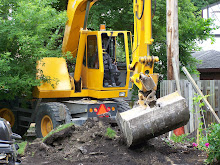Knowing that a few people will be planning to build their own fence in a few months, I thought that I'd post a few photos and some info to be helpful.
But first, I have to point out the very cool playhouse that was given to us - and then moved into our back yard in two pieces - just one day before the fenceposts went in (a day later, and we wouldn't have been able to get the playhouse into the yard).
The quick version of how we got the playhouse? A neighbour down the street wanted to get rid of it. They asked another neighbour - who owns a sign business and a crane - to move it. The crane-owning neighbour knows we have kids and asked if we'd be interested in having a playhouse. Our answer was "yes!" and the photos below tell the rest of the story.
The playhouse (and my four-year-old daughter):

The crane that our neighbour used to drop it onto our lawn (the roof was separated from the base during the move - both were hauled down the street on a big trailer):

 And now for the fence. While I like to do as much of my own work as possible, I'm a realist. Setting the posts properly is the key to a good fence, so I hired that job out. What would have taken me days to finish took the pros just over an hour. The company I hired used three guys and a bobcat with a post-hole auger attachment. (See the ad to the right for contact info - it's not a paid ad, by the way.)
And now for the fence. While I like to do as much of my own work as possible, I'm a realist. Setting the posts properly is the key to a good fence, so I hired that job out. What would have taken me days to finish took the pros just over an hour. The company I hired used three guys and a bobcat with a post-hole auger attachment. (See the ad to the right for contact info - it's not a paid ad, by the way.)I supplied the posts, of course. All they required was that I stake out the post-hole locations and have MB Hydro mark out the gas lines and any underground electrical cable (not an issue in our neighbourhood). They did the rest. The total cost was just over $500 for about 25 posts.
Here's a photo I took before they came in and placed the posts:

Here's another one:

And now for some fence photos. I decided to go with a very simple design. Rails on the top and bottom, boards spaced with about a 1/4" of daylight in between each one. The posts were set on a Sunday. Building the rest of the fence took two days plus an hour or two for the gates.



To sum up: getting someone else to set the posts was important to me. You can do it yourself, but you'd have to rent a power auger, buy your own gravel, and spend a whole lot of time getting the posts plumb and level. Definitely not worth it in my case.
The rest of it was straightforward, including the gates. It made for a fun July long weekend.
Any questions, leave a comment.






